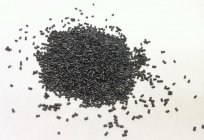The inventor of dynamite - Nobel. The history of the invention of dynamite
Alfred Bernhard Nobel-Swedish chemist, engineer and industrialist who invented dynamite and more powerful explosives, and also founded the Nobel prize.
Biography
The Future inventor of dynamite Alfred Nobel was born in Stockholm (Sweden) 21.10.1833. He was the fourth son of Immanuel and Caroline Nobel. Immanuel was an engineer who married Carolina Andriette Alltel in 1827; the couple had eight children, of whom only Alfred and three brothers reached adulthood. As a child, Nobel was often ill, but from an early age showed a living curiosity. He was interested in explosives and learned the basics of engineering from his father. The father, meanwhile, suffered setbacks in various business enterprises, until in 1837 moved to St. Petersburg, where he became a successful manufacturer of mines and tools.

Life abroad
In 1842, the Nobel family left Stockholm to join his father in St. Petersburg. Wealthy parents Alfred could now hire private teachers for him, and he was an impatient student. 16 years Nobel was a competent chemist, fluently speaking English, German, French and Russian languages.
In 1850, Alfred left Russia to spend a year in Paris studying chemistry and then four years in the United States, working under the guidance of John Erickson, engaged in the creation of the ironclad Monitor. On his return to Saint Petersburg he worked on his father's factory, producing military equipment during the Crimean war. At the end of hostilities in 1856, the company hardly moved on the manufacture of equipment for ships and went bankrupt in 1859
Recommended
"Knowledge is light and ignorance is darkness": the value, meaning and alternatives
There are some sayings that would seem to need no explanation, such as “teaching & ndash; light and ignorance – darkness”. But some still do not understand their meaning. But not only for such people is written by our article. I...
What was invented by Mendeleev for the army. The history and fate of the invention
D. I. Mendeleev was a brilliant Russian scientist-polymath, who made many important discoveries in various fields of science and technology. Many people know that he is the author of “Fundamentals of chemistry" and the periodic law of chem...
The origin of the Slavs. The influence of different cultures
Slavs (under this name), according to some researchers, appeared in the story only in 6 century ad. However, the language of nationality bears the archaic features of the Indo-European community. This, in turn, suggests that the origin of the Slavs h...

Bet on nitroglycerin
The Future inventor of dynamite in Russia does not remain with the parents returned to Sweden, and his brothers Robert and Ludwig decided to save the remnants of the family business. Soon Alfred began experimenting with explosives in a small laboratory on the estate of his father. At that time the only reliable explosive used in mines was black powder. Recently created liquid nitroglycerin was much more powerful, but he was so unstable that they could not provide any security. However, in 1862, Nobel built a small factory for its production, at the same time conducting research in hopes of finding a way to control its detonation.
In 1863 he invented a practical detonator consisting of a wooden plug inserted in a large charge of nitroglycerine stored in a metal container. The explosion of a small charge of black powder in the cap detonated with a much more powerful charge of liquid explosives. This detonator marked the beginning of Nobel's reputation as an inventor, as well as his status that he gains as a producer of explosives.
In 1865, Alfred improved has created a detonator cap, which consisted of a small metal cap with a charge of mercury fulminate, undermine, or blow, or by moderate heating. This invention was the beginning of the modern use of explosives.

Accident
The nitroglycerin, however, was difficult to transport, and it was extremely dangerous to handle. So dangerous that the Nobel's factory blew up in 1864, taking the life of his younger brother Emil and other people. Undaunted by this tragic accident, Alfred built several factories to manufacture nitroglycerin for use of his primers. These companies were as safe as possible knowledge of the time, but occasional explosions continued to occur.

Successful accident
The Second important invention of Alfred Nobel was dynamite. In 1867, he accidentally discovered that nitroglycerin is easily absorbed by porous silica, and the resulting mixture was much safer to use and easier to handle. Alfred – the inventor of dynamite (from the Greek δύναμις, “power”) – have had patents in Britain (1867) and the United States (1868). Explosives glorified his Creator in the world, and she soon became used in the construction of tunnels and canals, the construction of Railways and roads.

Blasting gelatin
In 1870–80 years of the inventor of dynamite, Alfred Nobel built throughout Europe the network of factories for the production of explosives and formed a network of corporations to sell them. He also continued to experiment in search of the best of them, and in 1875 created a more powerful form of dynamite, blasting gelatin, which he patented the following year. Again by chance he found that a mixture solution of nitroglycerin with a loose fibrous substance known as nitrocellulose, forms a dense, plastic material, possessing high water resistance and greater power of the explosion. In 1887 Nobel introduced ballistite, nitroglycerin smokeless powder and a precursor of cordite. Although Alfred had the patents to dynamite and other explosives, he was in constant conflict with competitorsstealing its technology, which several times forced him to conduct a protracted patent dispute.

Oil, arms, wealth
The Brothers Nobel, Ludwig and Robert, meanwhile, had developed newly discovered oilfields near Baku (now in Azerbaijan) the Caspian sea and became very wealthy men. Worldwide sales of explosives, as well as participation in companies brothers in Russia brought Alfred a huge fortune. In 1893, the inventor of dynamite, became interested in the military industry of Sweden, and the following year bought an iron smelting plant in Before, near Värmland, which became the center of the famous factory of arms. Besides explosives, Nobel invented many other things, such as artificial silk and leather, and overall, he has registered more than 350 patents in various countries.
Ascetic, writer, pacifist
The Inventor of dynamite, Nobel was a complex personality puzzled his contemporaries. Although business interests demanded his almost constant travels, he remained a lonely recluse who was prone to bouts of depression. Alfred led a solitary and simple life, he was a man of ascetic habits, but it could be a polite host and a good listener, and a man of penetrating mind.
The Inventor of dynamite was never married, and apparently preferred the joy of creativity to a romantic attachment. He had an enduring interest in literature, he wrote plays, novels and poems, almost all the remaining unpublished. He had amazing energy, and it was hard for him to relax after intense work. Among his contemporaries he enjoyed a reputation as a liberal or even a socialist, but he actually distrusted democracy, opposed suffrage for women and supported soft paternalism in relation to its numerous employees. Although the Swedish inventor of dynamite, in essence, was a pacifist and hoped that the destructive power of his creations will help put an end to the war, his view of mankind and Nations was pessimistic.

Will surprise
In 1895, Alfred developed angina, and 10 December of the following year he died of a brain hemorrhage at a private Villa in San Remo (Italy). By this time, the business Empire of Nobel consisted of more than 90 factories manufacturing explosives and ammunition. His will, drawn up in Paris 27.11.1895 and deposited in a Bank in Stockholm, contained a great surprise for his family, friends and the General public. The inventor of dynamite was always generous to the humanitarian and scientific charities and most of the fortune left in trust to establish the most highly valued international award, the Nobel prize.
Death of a salesman death
One Can only speculate about the reasons for the decision. He was secretive and told no one about any of his decision all the several months preceding his death. The most plausible is the assumption that a strange incident in 1888 may have triggered the chain of thoughts that led to his will. In the same year Alfred's brother Ludvig died while staying in Cannes, France. The French press reported his brother's death but confused him with Alfred, and one newspaper went with the headline “the Merchant of death is dead”. Perhaps the inventor of dynamite, established the prizes to avoid precisely this kind of posthumous reputation, which is expressed by this premature obituary. Obviously, awards have been instituted reflect his interest in chemistry, physics, physiology, and literature. There is also abundant evidence that his friendship with the prominent Austrian pacifist Bertha von Suttner inspired him to create the peace prize.
He Nobel, however, remains a figure, full of paradoxes and contradictions: a brilliant, lonely man, part pessimist and part idealist, who invented the powerful explosives used in modern warfare, and have established the most prestigious prize in the world for intellectual services rendered to humanity.
Article in other languages:
TR: https://tostpost.com/tr/e-itim/9582-mucit-dinamit---nobel-ge-mi-i-icad-dinamit.html
UK: https://tostpost.com/uk/osv-ta/9579-vinah-dnik-dinam-tu---nobel-stor-ya-vinahodu-dinam-tu.html

Alin Trodden - author of the article, editor
"Hi, I'm Alin Trodden. I write texts, read books, and look for impressions. And I'm not bad at telling you about it. I am always happy to participate in interesting projects."
Related News
Without adjectives our language would be bland and unemotional. This part of the question is responsible for ensuring that the named objects, persons, phenomena gained detailed characterisation of paint and awakened imagination.ad...
Of nitrifying bacteria. The importance of nitrifying bacteria
kind of all known living organisms are divided into two broad types: hetero - and autotrophs. A distinctive feature of the latter is their ability to independently build new elements of carbonic acid and other inorganic substances...
What is the most numerous group of mammals?
Mammals are the most highly developed and progressive of all the creatures that inhabit the earth. The number of known living species, about 5500, but when you consider those that died – 20 thousand. According to several mod...
Language development: the caress is...
What do you have of a noun weasel? Someone — with a small and fluffy animal of prey, the other — with positively colored emotions and actions, with tenderness and warmth. What is most interesting – and the first ...
the Armenian Genocide was organized in 1915, those areas of the country, over which ruled the Ottoman Empire. Quite often this period in Armenian history is called the Great Crime. it is believed that the Armenian genocide was car...
fluoride is often used in medicine and in other areas. Itself fluoride – substance in the gaseous state, so a source of fluoride, which are fluoride-fluoride with various substances, including metals. Some of these compounds...






















Comments (0)
This article has no comment, be the first!